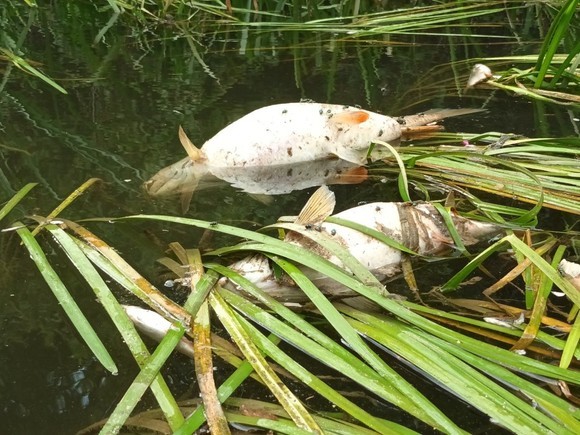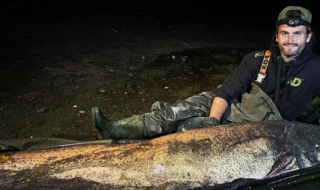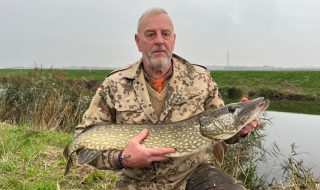The Angling Trust is demanding answers from Thames Water on the condition of their waste water infrastructure following the second pollution in a little over six months of the River Ray in Wiltshire, just upstream from its confluence with the River Thames.
The river suffered catastrophic pollution in the 1970s and again in 2003 but had recovered to become a popular fishery, holding good stocks of roach, dace, chub and perch with the occasional barbel. But in August 2022, the Ray suffered another major fish kill as a result of a burst in a rising sewer main at the Haydon Brook sewage pumping station on the outskirts of Swindon. Some 2,000 fish were thought to have perished and the Angling Trust negotiated substantial compensation on behalf of two local angling clubs to cover restocking and river restoration works.
However, this project looks likely to be stalled following the latest incident on March 1st which saw yet another leak from the same rising main with raw sewage flooding an industrial area before flowing off the land and into the river for a short period of time.
After the August pollution the Angling Trust pressed Thames Water to commit to a full review of their sewerage infrastructure in the Swindon area as there were fears that further pollution incidents were likely given the poor condition of the rising main. In October, Thames Water were still not prepared to commit to replacing the 3.2km section of pipeline but now they are pledging to have a new rising main installed later this year and fully operational by the middle of 2024.
As well as criticising Thames Water for their failure to protect the River Ray, the Angling Trust continues to highlight the failure of the water industry regulator OFWAT to approve adequate investment in the UK’s wastewater infrastructure with replacement rates for sewerage pipes operating on an absurd life expectancy of 2,000 years.
With other similar pollution incidents becoming more common, as sewerage systems break down through neglect and old age, Angling Trust CEO Jamie Cook has written to Thames Water boss Sarah Bentley to ask for the publication of a full audit of the water company’s most vulnerable sewerage infrastructure.
In his letter Jamie Cook says:
“I’m pleased to hear that you are now pledging to have a new rising main installed later this year and fully operational by the middle of 2024. This of course begs a number of questions. Why has it taken so long and a second pollution for you to decide to replace infrastructure that was demonstrably, and catastrophically, so obviously unfit for purpose? We then have to ask what reassurance can you offer that there are not other parts of your wastewater infrastructure in a similarly deplorable condition and likely to pollute other waterways?”
He continues: “By way of context I refer you to the recent report for Water UK which reveals that over 10% of pipes and sewers were installed during the reign of Queen Victoria and that a clear majority are at least 60 years and over. As you know the replacement rate for wastewater mains in England & Wales is lamentable and three times lower than the European average. In fact, industry insiders tell us that 20% of Thames Water’s rising mains are now over 100 years old and that something like 50% will be beyond life expectancy by 2050. This raises the prospects of serious pollution incidents such as we’ve seen on the River Ray and elsewhere becoming ever more commonplace. Economic
“My purpose in writing to you is to request a full public audit of all vulnerable Thames Water sewerage assets so that we can know better where the next pollution incidents are likely to occur and try to take steps to better mitigate both the risk and the damage to fish and wildlife. We will, of course, continue to lobby both OFWAT and the government to require and enable the water industry to overhaul and replace the wholly inadequate wastewater systems that are failing our environment on an almost daily basis.”
Martin Salter, Head of Policy at the Angling Trust, said:
“Last year we warned that any temporary repairs to ‘an already crumbling network will only last a short while before the next wipe out of fish and wildlife’ and this is exactly what has happened to the River Ray. Incidents like this are going to become more commonplace in the future right across the country unless there is a wholesale replacement and renewal programme of this country’s ageing, creaking and leaking sewerage systems.”
Dan Garner, Fisheries Officer for South Cerney AC said:
“There are no words to express how devastating this is to us at South Cerney Angling Club. This has now been the fourth serious pollution incident and the second sewage spillage since August last year. I can see no end to this problem until Thames Water have stepped up and renewed their failing infrastructure in question. Not only have they wiped out our section of the River Ray but it has also impacted fish stocks on our River Thames sections lower down.”
Vaughan Lewis, local anti-pollution campaigner from the Upper Thames Anglers Consultative added:
“Whilst Thames Water’s commitment to replace the failed sewer main is a move in the right direction, it cannot mask their negligence in failing to do so years earlier. In my view the inaction of previous CEO’s and directors has made them complicit in the death of thousands of fish before the company bowed to the inevitable. Thames Water should now face the full force of the law and be subject to criminal prosecution with severe penalties in line with the recent statements from the Environment Agency and government ministers.”






